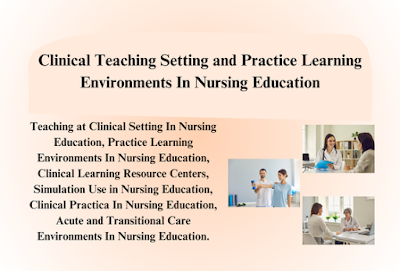Setting and Practice Learning Environments Nursing education is ever-evolving to meet the challenges of modern healthcare systems. With the Patient Protection and Affordable Care Act (PPACA) pushing for patient-centered, wellness-oriented, and technology-driven care, nursing educators must ensure students are well-prepared to navigate the complexities of contemporary healthcare. Central to this preparation is the clinical teaching setting, where students learn to apply their theoretical knowledge in real-world environments. This article explores various aspects of clinical teaching in nursing education, emphasizing practice learning environments, clinical resource centers, the use of simulation, and experiences in acute and transitional care settings.
1. Teaching in Clinical Settings in Nursing Education
Clinical settings in nursing education serve as essential environments where students practice critical thinking, clinical decision-making, and professional values. These settings, often situated within hospitals, clinics, and laboratory environments, enable students to apply their acquired knowledge in real-time, fostering growth and competence.
With healthcare becoming more complex, it is vital for clinical education to align with modern healthcare needs. Instructors in clinical settings play a crucial role in guiding students through hands-on learning while fostering their ability to make informed, patient-centered decisions. The integration of theoretical coursework with practical application ensures students develop a comprehensive understanding of their future roles in the healthcare system.
2. Practice Learning Environments in Nursing Education
Practice learning environments, also known as clinical learning environments (CLE), are pivotal in nursing education. These environments, where students interact with patients and families, facilitate the development of cognitive, psychomotor, and affective skills. The CLEs introduce students to real-world practice, helping them integrate theoretical nursing knowledge into patient care and develop clinical reasoning and judgment.
To maximize learning, students need exposure to a variety of clinical settings, including acute care, community-based environments, and transitional care. A supportive CLE encourages students to grow into competent professionals, equipping them with the skills to adapt to the dynamic healthcare landscape.
3. Clinical Learning Resource Centers
Clinical learning resource centers provide students with a non-threatening environment to hone their skills. These centers are often equipped with tools and technologies that simulate real-life scenarios, enabling students to practice psychomotor and cognitive skills before entering actual patient care environments.
Simulation is a key teaching method within these resource centers. It allows students to engage in critical thinking exercises and clinical reasoning while mastering the technical aspects of nursing. Simulation-based learning offers a controlled environment for students to refine their skills, preparing them for more complex patient interactions.
4. Simulation in Nursing Education
Simulation has become an integral component of nursing education. It offers a controlled, risk-free environment where students can practice complex procedures, clinical reasoning, and interprofessional collaboration. High-fidelity mannequins and human patient simulators (HPS) are widely used to replicate realistic clinical scenarios, enabling students to gain hands-on experience in a safe setting.
A groundbreaking multisite study demonstrated that students who spent a portion of their clinical time in simulation showed comparable results in clinical competency to those who spent more time in traditional clinical settings. This validation of simulation highlights its importance as a high-quality clinical learning tool, offering flexibility in the clinical education model.
5. Virtual Clinical Practica in Nursing Education
The rise of online technologies has opened new avenues for clinical education, particularly through virtual clinical practica (VCP). VCP enables students to participate in clinical experiences remotely, using telehealth technologies and virtual environments to simulate patient care scenarios. This approach addresses the challenges of securing clinical placements, especially in rural or underserved areas.
In a virtual practicum, students can observe and interact with nurses and healthcare teams, gaining experience in clinical decision-making and communication. The VCP model holds significant potential in nursing education, providing much-needed flexibility and access to clinical learning experiences.
6. Acute and Transitional Care Environments in Nursing Education
Acute and transitional care environments offer nursing students valuable opportunities to apply their skills in high-intensity, complex healthcare settings. These environments challenge students to utilize critical thinking, communication, and psychomotor skills while caring for patients with diverse and often acute needs.
The increasing complexity of these settings—marked by technological advancements, high patient turnover, and rapid changes in care needs—demands careful consideration of students’ readiness. Clinical educators must tailor learning experiences to ensure student safety and provide support as they navigate these challenging environments.
